Knitnut.net. Watch my life unravel...

|
Posted by Zoom! on March 29, 2007, at 7:47 pm |
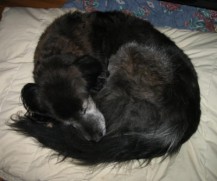 R.I.P. Sam: 1992-2007 R.I.P. Sam: 1992-2007
I got through it. But it was a heart-wrenching experience.
There are many stages of dying along the way to the end of a very long life.
For Sam, the first stage was when he went deaf a few years ago. The deafness, I think, was a fundamental loss to him. And to me.
The next phase began in January 2006, when he abruptly began showing signs of dementia. His deterioration – both physically and mentally, but especially emotionally – was like a series of small deaths.
Last night felt like another phase of death, as Sam slept peacefully at our feet while my son and I grieved together. When he woke up, he struggled with heartbreaking difficulty to his feet. We felt so sorry for him, but it reinforced for both James and me that the decision was right: it was time to let him go. This morning, before leaving for that final walk to the vet’s, I gave Sam extra treats and I cut some of the long hair from his ears, some for me and some for James.
There have been many little deaths over the past few days as I’ve done things with Sam, knowing this would be the last time. The last time I would ever throw a ball for him. The last time I would ever clean his tumour. The last time we would wake up together. The last pill, the last cookie, the last piece of cheese, the last walk….
He loved that last walk to the Bayview Animal Hospital. And everybody there was genuinely kind to both of us. So kind, I cried. They gave him all the treats he wanted, and a bowl of water, and lots of strokes and gentle words.
The euthanasia process involves several steps. They give you some time alone together in a cozy room, then administer a sedative (to the dog, of course, but I could have used one too), and then they give you a few more minutes alone together while the sedative takes effect. Next, they insert an IV tube, inject a flush solution to clear the tube, and finally they inject the euthanasia solution through the tube.
For the first few minutes after they administered the sedative, Sam was alert, relaxed and very focused on me; the connection between us felt stronger than ever. He even licked my face, which I *never* let him do. Then, as the sedative began to take effect, he started looking stoned and he needed to lie down, and then he didn’t make eye contact anymore. I felt like he was already dying – he wasn’t himself anymore. The connection wasn’t the same, and I knew it would never be the same again. I knew he was, at some level, already gone. I felt my heart break as I realized this, because I hadn’t said my final goodbyes yet. I thought we still had some time.
I was taken to another room to drink water and weep while they inserted the IV in his foreleg in preparation for the administration of the euthanasia drug. Then they brought me back into the room to be with him for his final minutes. He was lying on a comfy brown blanket on the floor, and he gazed at me through stoned eyes. I was grateful for the eye contact: I felt connected to him again. I sat on the blanket with him and he laid his head in my hand and I stroked him and told him I loved him. The vet injected the euthanasia solution into the IV and he died within thirty seconds, very peacefully and gently, with his head nestled in my hand, while I tried to be brave and failed miserably.
Even as she was injecting the final solution, I was questioning my decision. Was I doing the wrong thing? Was I doing the right thing too soon? Couldn’t we squeeze in a few more months of life? I wanted to change my mind.
I knew the moment he lost consciousness. His neck loosened and his head, still resting comfortably in my hand, rolled back towards the floor. He was gone. He started getting cooler almost immediately. But he was still a little bit there; I knew he wasn’t all gone yet.
The vet – she was so gentle and thoughtful – told me I could stay with him as long as I wanted. She left me alone with him. I don’t know how long I stayed. I just sat there on the blanket with him, talking to him, stroking him, praising him, apologizing to him, thanking him, as I worked my way through a box of kleenex. His nose started twitching, long after he died. The vet – fortunately – had forewarned me about the twitching, otherwise I might have thought he’d miraculously come back to life.
As I sat there, I thought about how completely and how purely he had loved all his favourite activities and favourite people over the years. I thought about how adorable his ears were when they were wet…his silky ear hair would get all crinkly. I thought about what kind of place his doggie heaven would be, if there were such a place. It would be outdoors, with water and rocks and logs and fields and good people with cheese and friendly dogs to play with and hump. There would be no smoke detectors, vacuum cleaners, thunderstorms, fireworks or pain, no ravages of time.
I gently pulled out a few clumps of loose fur and put them in my pocket. And finally, when I was sure he was all gone, I kissed him goodbye and left him behind.
I’ve gotten used to losing my dog in increments over the past few years, but there was always something left. Now, there are just reminders of him everywhere. His dish. His collar. His duvet. His rawhide bone out in the back yard, a Christmas present from James. Clumps of fur. Muddy pawprints. Blood on the walls. Medicine. Memories.
My dog has finished dying now. He’s finally all gone, forever.
(But I sense his presence everywhere.)
Posted by Zoom! on March 28, 2007, at 8:17 pm |
 I have an appointment to get Sam euthanized Thursday morning at 10:20. I made the appointment last week, and the last few days have been getting harder and harder. I’ll be fine one moment, and then suddenly I’ll start crying, sometimes even in public. I don’t know how I’m going to get through it. I have an appointment to get Sam euthanized Thursday morning at 10:20. I made the appointment last week, and the last few days have been getting harder and harder. I’ll be fine one moment, and then suddenly I’ll start crying, sometimes even in public. I don’t know how I’m going to get through it.
Yesterday he was acting like such a puppy at the park…he found a tennis ball and asked me to throw it for him, so I threw it and he chased it and brought it back four times, all happy and excited, just like when he was young and healthy. It made me happy to see him feeling so good. But it also made me wonder if I’m jumping the gun, or cheating him out of the last little bit of all he’s got left.
My son’s coming over to say goodbye to him tonight. I don’t know how I’m going to get through that either.
I remember the day we met Sam at the Humane Society. That was back when all the animals were on public display in kennels, and you would wander among them and pick the one you wanted.
We were going up and down the aisles, looking at all the dogs, and suddenly James, who was only 10 at the time, said with absolute conviction “This is him! This is my dog!”
I suggested that we finish looking at ALL the dogs before making up our minds, but he was adamant that he didn’t need to look at any more dogs, THIS was his dog.
“Why?” I asked.
“Watch this,” he said. And then he turned to Sam.
“Sit, Sam,” he said quietly. Sam sat.
“Shake a paw Sam,” he said. Sam put his paw against James’ hand, through the kennel bars.
“See?” said James, “He already understands me. He’s my dog.”
He was a handsome young dog, much redder then than now, with intelligent brown eyes and a calm, relaxed demeanor which stood out in that chaotic environment among the scores of excited and emotional dogs all shrieking “Pick me! Pick me!”
I still thought we should finish looking at all the dogs before making the final decision, but James was convinced that Sam would get scooped up in a matter of seconds if we left his side, since he was clearly the Very Best Dog in the Whole Humane Society, as anybody could plainly see.
He was right. And tonight, all these years later, he’s coming over to say goodbye to the Very Best Dog.
I don’t know how I’m going to get through this.
————————————————–
 James arrived just as I was writing that. We got through it, but this is what the coffee table looked like by the time he left. James arrived just as I was writing that. We got through it, but this is what the coffee table looked like by the time he left.
We’re both very sad.
Posted by Zoom! on March 27, 2007, at 7:59 pm |

graf·fi·ti /grəˈfiti/
“Markings, as initials, slogans, or drawings, written, spray-painted, or sketched on a sidewalk, wall of a building or public restroom, or the like: ‘These graffiti are evidence of the neighborhood’s decline.’ ” (dictionary.com)
(Graffiti is one of those weird plural words that sounds wrong when you use them correctly. Like data. ‘The data show…’ and ‘Graffiti are’ sound awkward. Actually, this whole parenthetical note sounds atrocious.)
“Graffiti are cross-cultural phenomena common to every literate society. Within the variable contexts of their production, graffiti personalize de-personalized space, construct landscapes of identity, make public space into private space, and act as promoters of ethnic unity as well as diversity. Graffiti can be understood as concrete manifestations of personal and communal ideologies which are visually striking, insistent, and provokative; as such, they are worthy of the continued attention of art historians, social scientists, and policy makers alike.” (from Art Crimes)
“The City of Ottawa and the Ottawa Police Service in partnership with representatives of the community are proud to be working together to eradicate graffiti vandalism as part of our role in reducing graffiti vandalism in our city.
To achieve this goal, our approach is based on a 4E model of graffiti management.
Eradication: Removing graffiti quickly and efficiently.
Empowerment: Maximizing use of available resources and relationships.
Education: Building awareness about how to prevent and remove graffiti.
Enforcement: Applying municipal and penal code laws when necessary.
“When you see graffiti in your neighbourhood, it is important to report it.”
(Ottawa Police)
Now there’s an absurd suggestion, and they can’t possibly mean it. I’d be calling the police constantly if I reported graffiti every time I saw it. The 4E thing is kind of silly too. Empowerment? Maximizing use of available resources and relationships? Does that actually mean anything? (Maybe it means that the PR team over at the Ottawa Police thought it would be catchy to have four words that started with the same letter, and they struggled to accomplish that.)
I’m not opposed to graffiti per se, although much of it is ugly, hastily scrawled and a waste of perfectly good wall space. On the other hand, there are some very talented graffiti artists out there who are, in my opinion, adding beauty and humour to the character of the city.
For example, here’s what’s on the Wallacks art store’s wall:

I love this one, which is also on the Wallack’s wall. I think it’s hilarious. This graffiti artist and I are probably on the same chapter of Drawing for Dummies.

This door says Zoom on it, but I didn’t have anything to do with it:

The bikini-clad alien is part of a series I like:
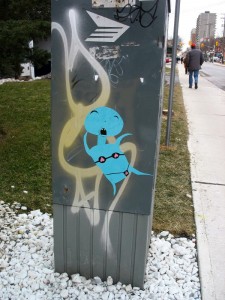
I laughed when I saw this innovative approach at graffiti deterrence. And I thought it was kind of sweet that the graffiti artists actually used it (in addition, of course, to the wall beside it).

While people complain about the economic costs of graffiti, you can see that it does contribute to the local economy in its own funny way:

 I’d miss graffiti if they somehow managed to eradicate it entirely, but I don’t think there’s any danger of that ever happening. If nothing else, graffiti artists are persistent and prolific. Speaking of which, does anybody know anything about the “No Air” graffiti? I see variations of it everywhere, but I have no idea what it means. I’m intrigued. I’d miss graffiti if they somehow managed to eradicate it entirely, but I don’t think there’s any danger of that ever happening. If nothing else, graffiti artists are persistent and prolific. Speaking of which, does anybody know anything about the “No Air” graffiti? I see variations of it everywhere, but I have no idea what it means. I’m intrigued.
Posted by Zoom! on March 25, 2007, at 8:53 am |
The art thing is coming along, but I’m a very slow and hesitant artist.
I’m drawn to computer art because it’s in my comfort zone. You can try something and if you make a mistake or just don’t like the effect, you can hit “undo.” Real art, with paint and glue and materials and stuff, is not so forgiving. Not only can I not draw a straight line, I can’t even glue straight. I end up frantically trying to reposition something before it’s permanently stuck in place, and then the paper is curling and sticking to itself and oh my god it’s stressful. But I’m persevering. I haven’t given up.
I try not to use anything I’m going to miss if I wreck it, since I probably will, but I have these attachment issues. I glue some text to a photocopy of a photograph, and the whole thing is absolutely re-createable, but I find myself getting attached to it: I’m afraid to take the next step because I haven’t wrecked it yet and I don’t want to. If I ever get anywhere close to finishing a piece, I’m going to be a nervous wreck.
I bought two paper packs at Wallacks the other day. They contain pieces of gorgeous papers of various types and sizes, which I can use in my collages. I’m reluctant to use the nice ones. I figure I’ll practice on the not-so-nice ones and save the best ones for when I’ve mastered the art of glueing. But that seems to be a weird way to go about making a collage…choosing only stuff you don’t much like.
I finally used one of the nice pieces of paper. It was a textured semi-transparent sheet when I started. Like a dryer sheet, only nicer. I took a 5×7 canvas. I glued a colour print-out of some antique sheet music on it as the background. Then I very carefully glued the 5×7 sheet of textured semi-transparent paper over that. I took a little break while waiting for the glue to dry, and when I went back, the paper had vanished. Vanished. I’m pretty sure it’s still glued on there, it’s just invisible now. So I’d say textured semi-transparent paper is anti-climatic.
I’ve done a few more digital collage Artist Trading Cards (ATCs) in the last little while. See?
Emit time:

Barefoot:
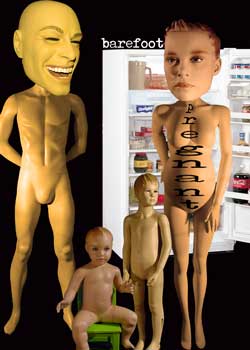
Japanese mannequin:

Nam myoho renge kyo:

This dress:
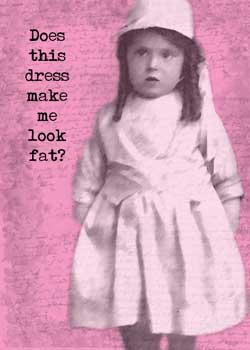
The ATC thing is kind of fun, because you make them and post them at the Artist Trading Card Forum, and then trade them with other people. Here’s how it works. Someone likes one of my cards and offers to trade. I look at their gallery, pick out one of their available cards, and we seal the deal and mail each other our cards. Traders usually include little art-making bits with the card, like paper scraps, so you get to add to your inventory of supplies at the same time. I like having something to look forward to in the mail: since Paddy died, my mailbox hasn’t had anything interesting in it, and now it sometimes does.
The other day I met Janet at the Shanghai for a lychee martini, and I was telling her about the ATC thing. She made me tell the guy who was serving us, since he’s into art. I started to explain it, and I used the term “mail art.” He replied, “Nudes?” It took me a moment to realize he thought I meant “male art.”
Which reminds me of the time my sister and I were in Mexico and we saw a peculiar animal in a cage.
“What kind of animal is it?” I asked the man in charge.
“A mayo,” he replied.
Hmm, how odd, a peculiar-looking animal that I’d never even heard of.
And then he pointed at another one, at the other end of the cage, and said “That’s a femayo.”
Posted by Zoom! on March 22, 2007, at 8:13 pm |
There’s a rare dress-wearing occasion coming up in my life. My sister Debbie is marrying Rob – the love of her life, and a really nice guy – in May!
This is the first wedding in our family. Up until now, everybody just eloped: my mom, both my sisters, and me. I wore jeans to my own wedding, but I’m wearing a dress to Debbie’s wedding.
Dress-shopping wasn’t as huge an ordeal as I feared it might be. I don’t like malls and avoid them as much as possible because they overwhelm and drain me. I went to St. Laurent Shopping Centre last weekend to look at dresses.
There weren’t a lot of dresses there, especially if you don’t count the prom dresses. I did see some interesting prom dresses. Check these out.
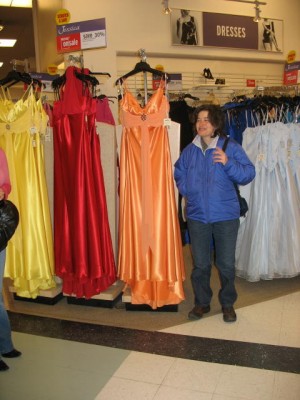
I know I’m not tall by any stretch, but I’m not freakishly short. If you stick a head and neck on top of these dresses, they’ll be 7 feet tall!
I didn’t buy a dress there.
BUT. I did buy two dresses at lunchtime on Wednesday. Why two? Because I have no fashion sense, so I have to let other people decide which dress I should wear to the wedding. I figured I’d buy two, canvas my friends, and let them decide which dress I should return.
My coworkers made me model both dresses when I got back to the office. They made me try on all their shoes. They tried to teach me how to walk in heels. They oohed and ahhed over the dresses and told me I should keep both. (Later I sent my sister photos of both dresses, and she advised me to return the navy one immediately. All her coworkers agree. All my coworkers say the picture doesn’t do the navy dress justice, it’s much cuter in person, and I should keep both dresses.) (My coworkers also say they’re impressed with how clean-shaven my legs are, but I should cut my toenails.) (They also advised me to buy the shoes soon – immediately after cutting my toenails – so I’ll have lots of time to practice walking in heels.)
Anyway, here’s me in the dresses. I still have to put together the shoes and accessories and cut my toenails, but it’s a good start. Your opinions are invited and encouraged.


Posted by Zoom! on March 20, 2007, at 10:54 pm |
I was just going through my old wooden box of antique paper photographs from the late 1800s and early 1900s, which is something I haven’t done for a few years. I’d forgotten how good my collection is. I’ve got lots of children with toys, tea parties, freaky old people, dead people, and tons of nuns. This is in addition of my ‘hard’ image collection of daguerreotypes, ambrotypes and tintypes, which go back as far as the 1840s. (Photography was invented by Louis Daguerre in 1839, by the way.)
I’m going to get a scanner and start scanning and posting an image a week from my collection. (I know, I started doing that with my daguerreotypes ages ago, and it lasted about two weeks…but I was in the middle of moving and it fell off the back burner.)
Many people think antique photographs are creepy. People rarely smiled, and for the most part they looked humourless and dour and burdened by the sheer effort of living. And it was, comparatively speaking, a hard life they were living. Basic grooming, for example, took monumental effort on their part. They had to haul water and boil it in order to take a bath. Laundry would have been a nightmare – they had all those kids (many of whom died, but still) and the women wore so many layers of huge clothing. All those layers for all those people had to be washed by hand, without the benefit of running water. (The Victorians were understandably smellier than us.)
I’m sure they smiled though, just not for the camera. When you think about it, why do WE smile for the camera? My son says in a couple of hundred years people will be collecting photographs from our era and wondering why we smiled so much.
This week’s antique photograph is a daguerreotype, which dates back to the late 1840s or early 1850s. I’ve chosen this one for two reasons: I already have a scan of it, and it’s not as scary as many of my images, because one of the two subjects is smiling (I’ll post the scarier ones once I’ve lured you in a bit).
A couple of quick facts about daguerreotypes, in case you’ve never seen one:
- they’re 3-dimensional objects in that the image is ‘printed’ on a silvered copper plate encased in glass, a brass frame and a folding case, often with a velvet pad opposite the image;
- each one is unique, since in essence the ‘negative’ is consumed in the making of the ‘print’;
- if you tilt a daguerreotype, you can see the image change from positive to negative and back again;
- many of the images being sold as daguerreotypes in antique shops or ebay are actually tintypes or ambrotypes; daguerreotypes have a mirrored quality and much greater depth and richness than ambrotypes or tintypes, which are flat.
- the original daguerrean era was short: 1839 to the 1860s. Dags were then replaced by ambrotypes. There are a few contemporary daguerreotypists working today, one of whom lives in Toronto and offers daguerreotype-making workshops. His name is Mike Robinson.
And now, without further ado, here is the antique image of the week:

See, that wasn’t so creepy, was it? The woman doesn’t exactly look like a barrel of laughs, but this image is all about the baby. This dag is poorly composed, there’s lots of wasted space above the subjects, and it lacks the richness and depth of a great dag. But it’s special to me because it’s my only smiler.
Posted by Zoom! on March 19, 2007, at 6:01 pm |
Ah, the Nostalgia Show! I love it. Yesterday was the day and I got up early so I could be near the front of the line when the doors opened at 9:00.
Here are a few of my favourite things. (You probably already know this, but just in case you don’t, you can click on any of the photos to see a larger version.)



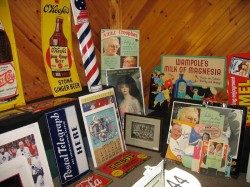


See that ugly smushy-nosed boy doll beside the bear? Don’t you think he’s got a certain irresistible charm? I bet you can’t guess where he lives now.
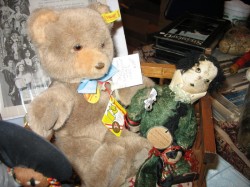
His name is Nigel and he lives at Chez Zoom (!) now, with what my sister describes as “Suzy’s creepy dolls.”
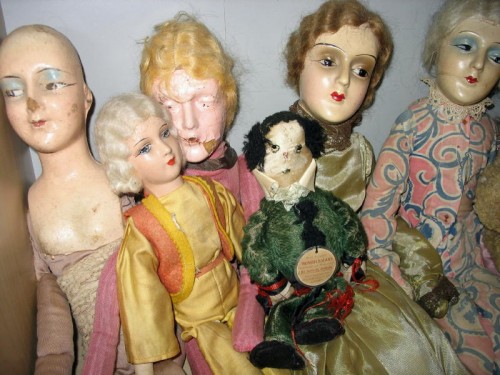
…and the world’s ugliest smushy-nosed bear.
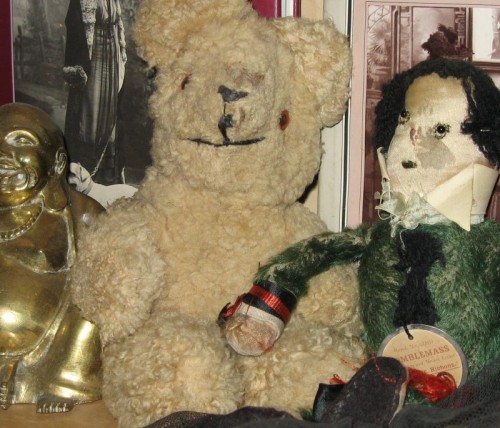
This bear was among my grandfather’s effects when he died. When my mother and her partner were going through his stuff, they came across it.
“It’s too ugly to keep, and it would be kind of sad to throw it away,” they mused, “Let’s give it to Susan.”
I adore him. I adore Nigel too.
Speaking of grandparents, my grandmother died peacefully in her sleep yesterday. She was 94, and the last of my grandparents. I didn’t know her very well, but she seemed nice.This is the only picture I have of her: it was taken at my christening I think. Both my parents, three of my grandparents, two of my great-grandmothers, and my sister and I are in here. My grandmother who died yesterday is the pretty blonde woman, third from the left in the back row. (I’m the slack-jawed baby.)

I guess you can’t ask much more of life than ninety-four good years and a peaceful death. Rest in peace Grandma.
Posted by Zoom! on March 15, 2007, at 7:58 pm |
A plump vibrant snowwoman sprung to life last week, right beside my bus stop. (Does snowwoman have two w’s or one? It looks wrong both ways.)
I photographed her every day throughout her short life. This is Snowwoman on March 9th.

Here she is at 7:00 AM on March 13th, looking a little thin and bedraggled, poor thing. A little limp around the edges. A little desperate and haunted around the eyes.

This is Snowwoman at 5:15 PM that same day: dead, at the tender age of 4.5 days, cut down in the prime of her life by Mock Spring.
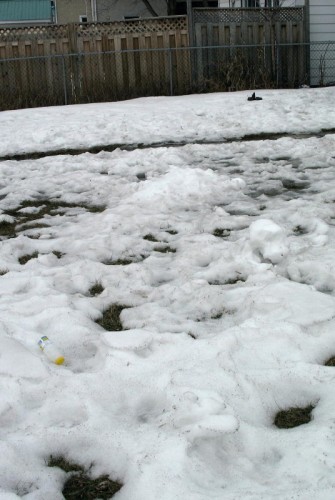
Despite witnessing the indignities suffered by poor sweet Snowwoman, I enjoyed Mock Spring. We basked in thirteen delicious degrees yesterday. I took my hat and mittens off, but I wasn’t gullible enough to put my boots in the basement just yet, or go out motorcycle-shopping. I’ve been through enough seasons in my life to know winter isn’t going to surrender in the first round. And see? The mercury’s dipping down to minus 13 tonight and minus 17 on Monday.
If only Snowwoman could have hung on through Mock Spring, she’d have had a new lease on life. I tried to tell her that on the morning of the day she died, but she couldn’t hear me: her ears were lying in a puddle at her feet.
Posted by zoom! on March 13, 2007, at 6:12 pm |
This morning I walked to work, opened up the office, turned the lights on, made the coffee and took the mail over to the post office while waiting for the coffee to brew.
 The post office is in the L’Esplanade Laurier: it’s one of those little privatized outlets. It’s run by slow-motion imbeciles. Victor is elderly, dense and painfully slow, and he has a very bad comb-over. His movements are barely perceptible. He measures everything, even standard-sized envelopes. S l o w l y. He speaks slowly and indistinctly. He never looks up. He is oblivious to everything around him except for the one miniscule detail he’s attending to at any given moment. (This is a picture I snapped of him later in the day.) The post office is in the L’Esplanade Laurier: it’s one of those little privatized outlets. It’s run by slow-motion imbeciles. Victor is elderly, dense and painfully slow, and he has a very bad comb-over. His movements are barely perceptible. He measures everything, even standard-sized envelopes. S l o w l y. He speaks slowly and indistinctly. He never looks up. He is oblivious to everything around him except for the one miniscule detail he’s attending to at any given moment. (This is a picture I snapped of him later in the day.)
There’s a woman there sometimes who moves a bit faster than Victor, but treats everybody with contempt and acts like she resents the customers for showing up and buying things. You ask for a stamp and she sneers at you. You ask how much it costs to mail this letter to New Zealand and she heaves a huge sigh and rolls her eyes.
Sometimes there’s a younger woman there who moves a little more quickly and efficiently. She appears not to wash her hair and she wears badly pilled jogging pants with “Spoiled” written on the ass. (I am no fashion maven myself, so when I criticize someone else’s clothes, you know it has to be bad.)
My office has an account at this postal outlet, so I’m supposed to go to the side counter, hand over my stack of mail, and leave. This way I don’t have to wait in the main lineup, which is about four feet away. It’s a very small postal outlet, but the staff are completely lacking in peripheral vision and they never look up, so they never see me there. As a result, I often end up waiting longer than I would if I were in the regular lineup.
Anyway, I’m standing there with my mail while Victor (who is the only one working this morning) deals with the only other customer. In fact, as I arrive, their transaction is complete. He watches while she slowly pockets her change and puts her receipt away. I stand there waiting patiently. She glances at me and then she decides to strike up a conversation with Victor.
“Do you know,” she said (in what I believe was a German accent), “When I first came here in 1992, I went to the post office on Rideau Street and I was so surprised by how nice everybody was.”
“brg,” murmured Victor.
“I took a long time because I didn’t understand how it worked in Canada,” she continued, “and when I turned to leave, I saw there was a long lineup of customers behind me, waiting.”
Victor made a gurgling noise.
“And you know, those people didn’t even get angry at me for taking so long,” she said.
Victor nodded slowly.
“That’s what I love about this country,” she went on, “Nobody’s impatient.”
Meanwhile, I’m standing there, growing increasingly impatient.
“Rgh dm bl ek,” said Victor.
“People are so understanding here,” she said, “Nobody ever gets angry.”
“Vg isi,” said Victor, “Ek jnglg flug.”
I coughed. I shifted from foot to foot. I looked at my imaginary watch.
“You can stay for a few extra minutes and have a pleasant conversation and people don’t mind waiting until you’re finished,” the woman said.
By this point I’m starting to wonder if she’s deliberately trying to piss me off. Because I’m seriously getting pissed off. The irony is not lost on me, but I’m too irritated to appreciate it. I just want to hand Victor the mail and get back to my office. He could just reach over and take the mail from me while continuing this conversation if he were capable of doing two things at the same time, but so far he hasn’t even noticed me standing there. But the customer has: she keeps glancing at me while she talks.
“In my country, people aren’t like that,” she said, “Everybody’s always in such a hurry. Rush, rush, rush. Not like the patient Canadians, who always have time to be nice.”
“FUCK,” I screamed under my breath, “Just shut up and leave already!”
“I like it better here,” she said, “People don’t mind waiting until you’re done. People don’t mind if it takes a few extra minutes to be pleasant.”
“Blg inki brah shmnz,” said Victor slowly.
It didn’t stop there. It went on and on.
Finally I couldn’t take it anymore. I was too pissed off to stand there waiting for this endless drivel to end. I turned around and stomped out. Of course I got about 50 paces away and thought better of it. If I didn’t drop the mail off now, I’d just have to come back and do it later when there would be more people in the lineup. I stomped back in.
“Oh here’s another customer now,” said the woman brightly, acting like she’d never seen me before.
“An impatient one!” I snapped impatiently. I actually said that out loud, while glowering at her.
I’m usually much nicer than this.
Posted by Zoom! on March 11, 2007, at 10:09 pm |
 This one morphed out of some emerging ideas about reflections and mirrors and the passing of time and how perception warps reality sufficiently enough that we should be vigilant about what we tell ourselves. This one morphed out of some emerging ideas about reflections and mirrors and the passing of time and how perception warps reality sufficiently enough that we should be vigilant about what we tell ourselves.
I’m thinking about doing some art to harmonize with Theodore Roetke’s poetry. Roethke was mentally ill. (What is it with poets and madness anyway?) He has been my favourite poet ever since I first read The Far Field as a teenager. In fact, when I ran away from home I had three items in my wallet, and one of them was a verse from The Far Field:
I learned not to fear infinity
The far field
The windy cliffs of forever
They dying of time in the white light of tomorrow
The wheel turning in on itself
The sprawl of the wave
The oncoming water
The second item in my wallet – and this is a bit embarassing, but I guess it struck a chord in my 15-year-old soul – was straight from the Statue of Liberty:
Give me your tired, your poor,
Your huddled masses yearning to breathe free,
The wretched refuse of your teeming shore.
Send these, the homeless, tempest-tost to me,
I lift my lamp beside the golden door
And the third item in my wallet was a photograph of Paddy Mitchell, torn from the newspaper.
I’m not sure why I took these things and not other things, but I suspect they gave me courage and made me feel less alone.
I also took my baseball glove, but not in my wallet of course.
On a completely different subject, I seem to have lost misplaced the usb cable for my camera, so all my recent photos are temporarily unavailable. I’ve got snowmen and birthday parties and banjo players and a loom all trapped inside my camera. I’m selling my loom: it’s huge, I’ve moved it three times, I’ve never used it, and it’s time to find it someone who can look at it without feeling guilty. Maybe we all have something like that. Mary Jane has a harp. She plays the harp about as often as I weave: never, not even once.
Today’s the first day of Daylight Savings Time. It’s 11:03 p.m and I’m having trouble figuring out whether that means it’s really 10:03 or 12:03.
Okay, I appear to be rambling, so I’ll call it a night now. Thanks for bearing with me.
|
|



















































Popular Posts